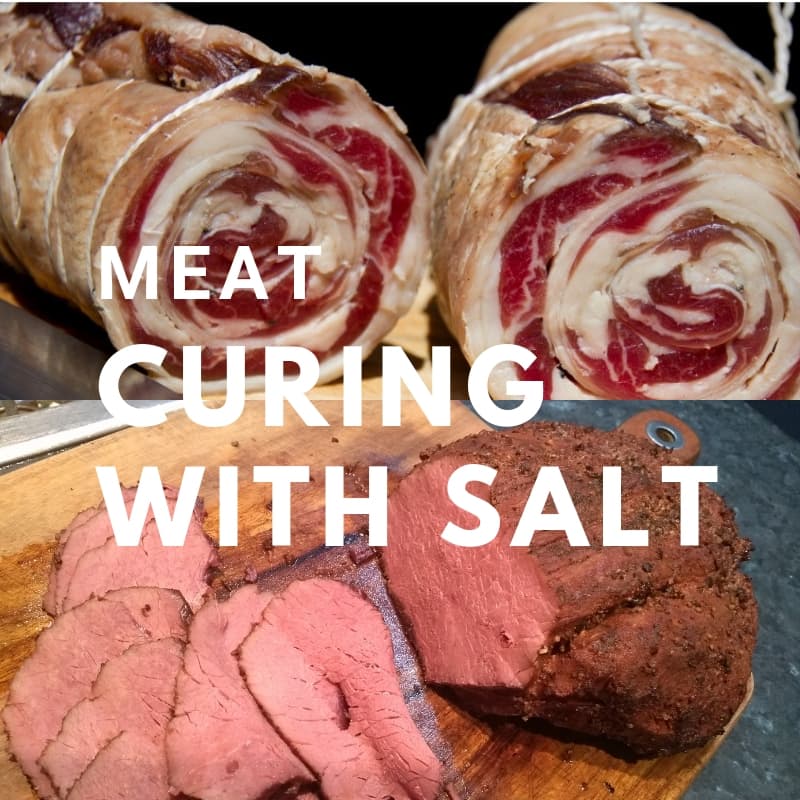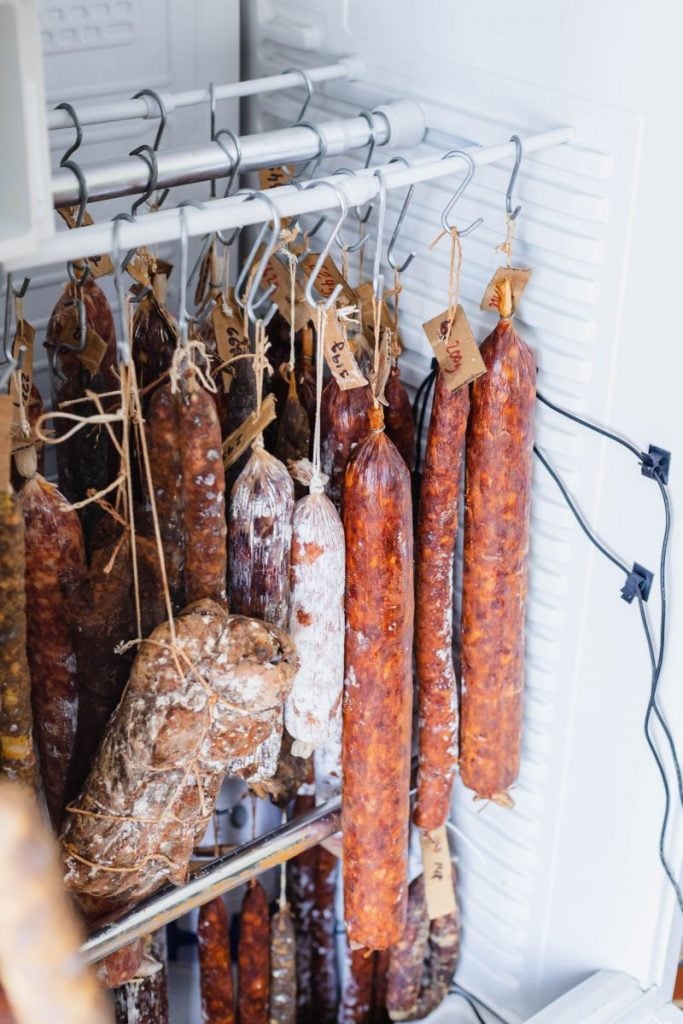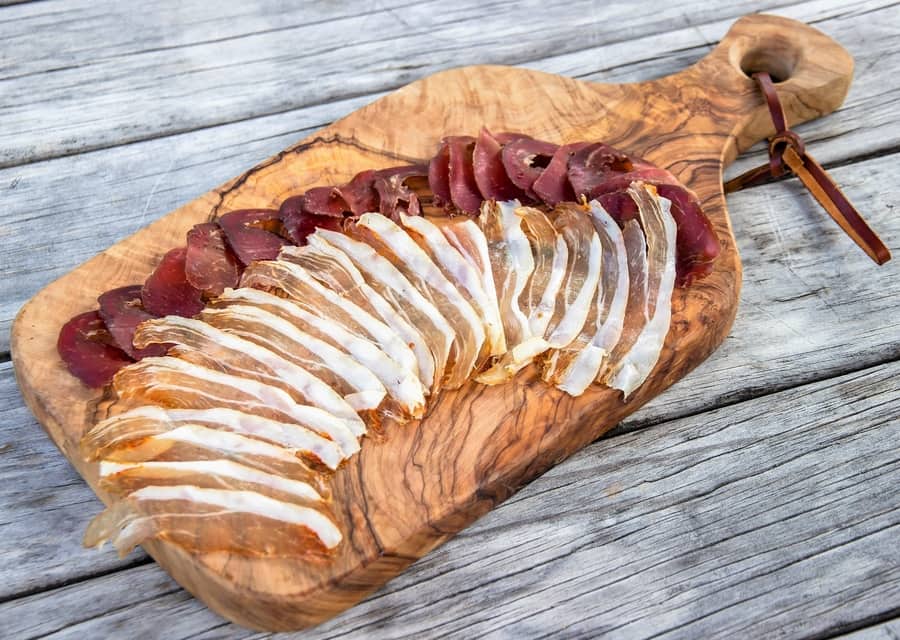Salt is the foundation of curing meat. Long before pink curing salts with nitrites and nitrates were created, people relied entirely on sea salt.
In this first section, I’ll explain why sea salt is always the base for meat curing, the types I use, and the salt levels for seasoning, cooking, and dry curing projects.
I’ll also go over some confusion about the salt curing agents, like pink curing salt, and give some examples specifically about how I use it.

Using Sea Salt for Meat Curing
Sea salt doesn’t just season meat — it changes the environment inside it. By reducing water and shifting the balance within the muscle, salt makes it harder for bacteria to survive. At the same time, it enhances texture and flavor.
Water Binding & Moisture Reduction
Salt ties up water molecules and draws surface moisture out of the meat. This creates a drier environment where harmful bacteria struggle to grow, extending shelf life naturally.
Inhibiting Harmful Bacteria
With less available water, microbes can’t thrive. This is why salt has been the most trusted preservative across cultures for thousands of years.
Different Forms of Salt (Sea, Kosher, Pickling, Table)
I’ve experimented with many salt types. Purity, additives, and granule size matter more than most beginners realize — especially when you’re weighing small amounts precisely.
Recommended Options for Curing
- Pure Sea Salt – my first choice for dry curing. Natural, reliable, and mineral-rich. Fine or medium granulation dissolves evenly.
- Kosher Salt – ideal for brining or large cuts; flake size varies between brands, so always weigh it (don’t use spoons).
- Pickling Salt – dissolves instantly in brines and contains no additives; great for wet cures.
Additives to Avoid (Iodine/Anti-Caking Agents)
I don’t use table salt for curing. Iodine and anti-caking agents can affect flavor and sometimes interfere with curing. Stick with pure salt.
Projects Where Sea Salt Alone is Used
The amount of salt depends on the style of project. Here’s how I categorize it:
Seasoning (0–2% of Meat Weight)
Salt at this level is for taste only. I use around 1.3% in fresh grilling sausages. It enhances flavor but isn’t aimed at preservation.
Cured & Hot-Smoked or Cooked (1-2%)
For meats that are salted, then cooked or hot-smoked — like corned beef, bacon, or pastrami — I use about 2%. It seasons well and supports the curing step before heat finishes the process.
Dry Curing (2–4%)
Long projects like bresaola, coppa, or traditional ham usually need 2–4%. The higher salt ensures food safety during months of drying while also creating the dense, flavorful texture of true dry-cured meats.
Note on Pink Curing Salt
Alongside sea salt, there’s pink curing salt. It serves a different role, adding safety to certain projects. It’s not required in every cure but is often confused with sea salt.
Why It’s Different from Sea Salt
Pink curing salt contains sodium nitrite or nitrate. It’s not about seasoning or drying, but about preventing bacteria in longer or riskier cures.
Covered in Detail Later
Note: I’ll cover pink curing salt in detail further down. For now, remember sea salt is always the base, while pink curing salt is optional depending on curing time and method.
How Much Salt to Use (Equilibrium Curing Basics)
The right amount of salt is crucial. Too much, and the meat becomes harshly salty; too little, and the cure won’t protect the meat. I rely on equilibrium curing — precise percentages of salt based on the meat’s weight — instead of old-fashioned “handful” or spoon measures. This method produces consistent, repeatable results every time.
Base % for Sea Salt (2–4%) + 0.25% Curing Salt if Used
For most curing projects, I use 2–4% sea salt. If the project requires pink curing salt, it’s added at 0.25% of the meat’s weight. That small amount is all it takes to add protection and help develop cured color without affecting flavor. When I first started curing meat, weighing everything felt overkill, but now I see it as the only way to get reliable results.
Scale Accuracy & Deeper Guide
Accurate scales are essential — at least to one decimal place, ideally two. Even being off by half a gram can throw a cure off balance. If you want a full walk-through of this method, I put together a dedicated post here: Complete Guide to Equilibrium Curing Meat.
Worked Example (1,000 g Pork Belly)
Say you’re curing a 1,000 g piece of pork belly. At 2.5% sea salt, you’d use 25 g. If you’re adding pink curing salt No. 1, include 2.5 g (0.25%). Altogether, that’s 27.5 g of curing mix. With equilibrium curing, the meat won’t end up too salty because the percentages are fixed to its weight, and all the salt eventually diffuses evenly into the meat.
Expert Tip: Always label the bag or tray with meat weight, salt percentages, and date. I also let the meat rest in the fridge for 12–24 hours after curing to equalize before smoking or drying.
Sea Salt vs. Pink Curing Salt (The Big Difference)
Sea salt and pink curing salt are not interchangeable. Sea salt is the base preservative used for all curing projects. Pink curing salt is an additional layer of protection used in specific cases, and it must always be measured precisely. I’ve seen beginners confuse Himalayan pink salt with pink curing salt — but they are not the same thing.
What Pink Curing Salt Is (Not Himalayan Pink Salt)
Pink curing salt is a blend of regular salt with sodium nitrite (and sometimes sodium nitrate). It is dyed pink so it can’t be confused with table salt or sugar. Himalayan pink salt, by contrast, is just mineral-rich cooking salt with no nitrates or nitrites. For a detailed guide on using curing salts, see my breakdown here: Guide to Using Pink Curing Salt at Home.
Pink Curing Salt No. 1 (Short-Term, Under 30 Days)
No. 1 is used for curing projects that take less than 30 days and will be cooked or hot-smoked before eating. Typical examples are bacon, corned beef, pastrami, and certain luncheon-style meats. The correct amount is 0.25% of the meat’s weight.
Pink Curing Salt No. 2 (Long-Term, Over 30 Days)
No. 2 is used for dry curing projects that last months, such as bresaola, coppa, lonza, prosciutto, and traditional dry-cured salami. It contains both nitrite and nitrate, the latter of which breaks down into nitrite over time, offering protection throughout the drying period. Usage is the same: 0.25% of the meat’s weight.

Why Curing Salt is Dyed Pink (Avoid Confusion)
The pink coloring is purely a safety feature. It ensures curing salt isn’t accidentally mistaken for table salt or sugar. Since it’s only used in tiny amounts, correct labeling and storage are vital.
Meat Curing for Hot Smoking
Hot smoking sits between cooking and curing. Meat spends hours in the “danger zone” of warm, low-oxygen conditions where harmful bacteria could grow. This is why Pink Curing Salt No. 1 is commonly used — it provides a safety margin and also gives the meat its distinct cured flavor and pink color.
Why Pink Curing Salt No. 1 is Used for Hot-Smoked Meats
No. 1 is formulated for projects under 30 days that will be cooked or hot-smoked. It prevents bacteria like Clostridium botulinum from surviving in the low-oxygen environment of a smoker. At the same time, it reacts with proteins to give cured meats like bacon and pastrami their signature color.
Examples: Pastrami, Corned Beef, and Bacon
Pastrami, corned beef, and bacon are classic hot-smoked cures. Without curing salt, bacon would cook to a greyish color. With curing salt, it takes on the rosy cured appearance and flavor that people expect.
How Nitrite Works During Smoking
Nitrite helps protect meat through the smoking process and enhances the finished product. For background on cured bacon safety, see the USDA overview here: Bacon and Food Safety (USDA).
Often in the USA, some bias about using nitrates/nitrites, for homemade meat curing in Europe its often leaning toward a different direction.
Expert Tip: After curing, rinse and pat the meat dry, then allow it to air-chill uncovered in the fridge for 12–24 hours. This forms a tacky surface called a pellicle that helps smoke stick evenly, giving better flavor and color.
Projects That Don’t Require Curing Salt
Not every hot smoking project I do, uses salt curing agent. Fish such as salmon are often hot-smoked with just sea salt. BBQ “low & slow” cuts like brisket, pulled pork, and ribs are also simply seasoned and cooked — the smoke is for flavor, not preservation.
Fermentation vs. Dry Curing

Not all cured meats are fermented. Most whole muscle cures — like prosciutto or coppa — rely purely on salt and controlled drying. Fermentation mainly applies to salami, where acidity is adjusted before the drying begins. When I started making salami, I learned that controlling pH was as important as controlling temperature and humidity.
When Fermentation Applies (Salami)
Salami is a mixture of meat and fat stuffed into a casing. Unlike a whole muscle, the ground meat doesn’t have natural structure to resist bacteria. That’s why fermentation is often used — to create a safer, more consistent product.
pH and Acidity
Starter cultures consume sugars and produce lactic acid, lowering pH. This creates an acidic environment that slows harmful bacteria and gives salami its tangy flavor. It’s not required for every recipe, but it adds both safety and character.
Drying Conditions & Weight Loss
After fermentation, salami is dried at controlled humidity and temperature. I track weight loss to know when it’s ready — usually 30–40% depending on style. Whole muscle cures don’t need this step; they simply dry over time, with salt and airflow doing the work.
Expert Tip: Keep a curing log. Note meat weight, salt percentages, and drying environment. Tracking progress helps troubleshoot and improves consistency with every batch.
Do You Need Curing Salt?
Whether you need pink curing salt depends on the project. Some traditional styles rely only on sea salt, while others almost always include curing salts.
I’ve made both kinds and still enjoy experimenting. For me, the decision usually comes down to how long the cure will last and whether it’s hot-smoked or eaten raw after drying or cooked over 350°F.
Projects Commonly Done Without Nitrites/Nitrates
Some curing styles don’t need curing salt at all. Gravlax is a classic example — salmon cured with salt, sugar, and dill, ready in a few days. Hot-smoked fish and BBQ “low & slow” cuts like brisket or ribs are also made without it since they’re fully cooked. I go into more detail on this here: Can You Cure Meat Without Nitrites/Nitrates?
External Note: Broader studies, such as this NIH review, explain dietary nitrates and nitrites in context. For home curing, I stick to precise percentages and proven recipes rather than guesswork.
FAQs
Are Curing Salts Used in Traditional Dry-Cured Meats in Italy?
Yes. Famous examples like Parma Prosciutto use only salt and pork, but many other Italian salumi include curing salts.
What are Substitutes for Pink Curing Salt?
Celery powder and beetroot powder are natural substitutes. They contain nitrates/nitrites, the same compounds found in synthetically made curing salts.
What’s the Difference Between Himalayan Pink Salt & Pink Curing Salt?
Himalayan pink salt is regular mineral salt with no nitrite/nitrate. Pink curing salt contains sodium nitrite or nitrate and is only used in small amounts for curing.
How Long Does Pink Curing Salt Last?
Stored airtight in a cool place, pink curing salt lasts for years. Discoloration over time doesn’t reduce effectiveness.
What is Pink Salt?
Himalayan pink salt is a cooking salt with trace minerals. Pink curing salt is dyed salt with nitrite/nitrate for curing meats like bacon, pastrami, and salami.
Are Prague Powder 1 and 2 the Same as Pink Curing Salt?
Yes. Prague Powder #1 = Pink Curing Salt No. 1. Prague Powder #2 = Pink Curing Salt No. 2. They differ only in the addition of nitrate in No. 2.
Have questions or your own curing experiences to share? Leave a comment below — I’d love to hear about your projects and what salts you prefer using.

Tom Mueller
For decades, immersed in studying, working, learning, and teaching the craft of meat curing, sharing the passion and showcasing the world of charcuterie and smoked meat. Read More

Really enjoyed reading this, great information, many thanks.
I am a small scale, organic, free running, pig breeder in Wales.
Just looking for different methods and recipes to produce at home.
Hey Chrissie, thanks for the feedback!
I can imagine you have quality meat! Are you interested in building a curing chamber and/or a charcuterie course I’m putting together? I can add you in.
Cheers
Tom
I am drying beef for a pemmican recipe. The beef will be sliced thin, dehydrated and ground into a course powder. Pemmican should last 5 to 10 years and I’ve heard of some recipes lasting even longer.
I need to use salt in the dehydrating process, which salt would you recommend for this?
I havent tried pemmican, interested in the results.
Plain sea salt for with no additives or caking agents
Cheers
Tom
I love Himalayan pink salt and use it in BBQ rubs, also when I make beef jerky. I use a pellet grill for the jerky. it has a minimum temp. of 160 F. Is Himalayan salt good for curing or should I get sea salt?
Cool Dale, my preference is sea salt brands without additives, since it doesn’t have unknowns. Himalayan pink salt seems to have all sorts of different minerals, i do not know know the effects of these ‘other’ minerals. Personally, I stick to sea salt for consistency. Remember Himalayan pink salt and pink curing salt are very different too.
I make biltong, which uses sea salt, vinegar, coriander to acidity and cure then dry. I don’t cook it. But I realize you are cooking the jerky, different styles!
We avoid artificial coloring in our foods. I would like to make pastrami at home. What can I use instead of artificially died curing salt: Does anyone make a curing salt without artificial dyes?
Hi Susan,
I can only give you an indication of what I do.
Pink Curing salt reacts with myoglobins in meat, changing the color. Using pink curing salt is a personal choice, for certain whole muscle projects I don’t use pink curing salt. For dry cured salami I do. That choice is yours, for me it comes down to having a solid process and recipe – and most importantly quality meat where you know its origin and traceability. All the alternatives like celery powder etc… have nitrate/nitrates (depending on no1 or no2) – therefore will react with the myoglobins.
All the best, Tom
Hi Tom, I have a pork shoulder I want to dry cure but only have pink curing salt #1. Seeing as people successfully cure meat all the time with just Kosher/table salt, I feel like I should just go for it instead of waiting 2 weeks for Pink #2 to arrive from Amazon. Bad idea?
Up to you Todd. Do you trust the meat and how it has been handled?
When I harvest meat, I cool it and know where its been etc.. So using sea salt for ‘whole muscle’ I am happy with.
Idea of No. 1 is under 30 days, so most of it is gone. Idea of No.2 is breakdown slower hence why its used for over 30 days.
Table salt = might have additives / Kosher generally better.
End of the day I am sharing my adventures, but you have to make the call sir!
Hi Tom,
Interesting read, thanks for the information. I see you haven’t mentioned wet cures, I’m intending on doing a wet cure bacon, would you recommend Prague/Pink Salt #1 for this?
Hey Jimmy! Dobry! Yes for less then 30 days and cooked things, people use curing salt no. 1. However, I am frying the bacon above 350F approx 170C, I leave it out because of the possibility of nitrosamines forming at high heat.
Here is another bit of info too. https://eatcuredmeat.com/what-is-how-to-use-pink-curing-salt-or-prague-powder/
Cheers
Tom
I am going to make country hams. I need to be sure I am doing things properly. 1. Some recepes call for salt peter. If I use #2 cure what is the conversion. Teaspoon for teaspoon? #2 What is a good salt to use. Edwards Hams used a flake salt. Do you have a recommendation. Thanks
I would be using a recipe like this, I haven’t made a country ham before, good luck!
Cheers, T
Hi Tom, I want to dry cure a small portion of beef loin (200-300g). I have #2 curing salt, but what if my meat loses 35% of its weight before the 30 days? Is it okay to eat before then? Thank you!
Hey I wouldn’t!
Hi Tom, I butchered a wild boar and set the rear leg aside to salt cure into prosciutto. I had kosher salt, so I mortar and pestled it and patted it into all the exposed meat surfaces (weighing 9lbs. 11oz.). After 2 days it dropped to 5lbs. 9oz.
Have I wrecked it? Should I abandon the idea of prosciutto and just cook this hunk of meat? I’ve never cured meat before, and am worried about botulism..
Hey there, Impossible, you must have weighed it wrong, you might want to start with a more short-term project first.
Also, check out I wrote about the basics.
Hi there, the 9lbs was just after I shot and hung the boar. It dripped out well over 6 cups of water/liquid into the bin that I placed below it. At first I thought it was an issue with my scale, but the leg seems to have shrunk 3 inches in length and feels so light. Maybe I should have aged the meat longer prior to curing it with salt, I just got impatient. I also had a fan on it for the last couple days.
crazy, i have no idea
Hi Tom, I saw in an old comment in 2020 that you were putting together a charcuterie course and/or building a curing chamber. I am interested in finding more about both please. Since retirement, my dad has been curing meats and making his own sausages. This would be a fantastic gift for him.
Kind regards
Lesley
Hiya Lesley, thanks yes the course has been popular – here is the link –
All the best, Tom
If I’m curing my coppa in salt and then rinsing it with wine do I add the curing salt 2 with the regular salt or when I coat the coppa with spices?
with salt! cheers Tom
I’m making air dry cured sausages with ground venison. Since it is ground meat and is not to be cooked I used Prague Powder #2. However sausages dried in 10-14 days. After the drying process I usually vacuum pack them and put them in the freezer for later consumption (take few out as needed and keep them in the fridge until consumed) Questions:
1. Are sausages safe to eat now, immediately after they dried (14 days)?
2. Are they safe to eat after being in the freezer for extended period of time : months to a year?
3. Will the Nitrate continue to break down in while sausages are in the freezer? If not, should I vac pac the dried sausages and keep them in the fridge for a month before I move them to the freezer?
4. Should I use Prague Powder #1 in my case. My confusion is that my drying period is about or even less than 2 weeks but I’m not cooking the meat.
No idea, don’t know recipes or how you have dealt with meat, did you lose 30% weight? No.1 is used for under 30 days. You aren’t really defining what your ver. of ‘dried’ is.
Regards Tom
Yes, they lost 30% of their weight. The way I handle the meat is after I harvest the deer I debonair the meat and keep it in a cooler with ice to drain as much of the blood as I can. Then if the weather is still warm outside I freeze it until outside temperatures fall below 40F for 2 weeks. Then I thaw the meat cut in smaller pieces mix it with the spices and cure, and let it sit in the fridge overnight. Then I grind the meat, and stuff it in natural beef casings. I hang the sausages on rods outside during the day and move them in the garage during the night to protect them from animals. I’ve always checked if the dry enough by pressing to see how soft they are. I know it is not scientific but it has been good enough so far. No I would like to improve my methods. In the past I have used just salt and this year is the first year I’m using cure. So, to the questions above I would like to add what do youbuse to check for moisture content. I hope this will give you enough information to answer my original questions. Thanks in advance.
I can’t give you definite answers without seeing, smelling and look at them. This guides most of my decision.
If they were thin casings maybe 22mm or under, a fast drying like this could occur I presume. beef casing is larger from my experiences.
I dont freeze dry cured meat, I vacpac it generally, I’ve had a friend freeze Italian prosciutto. He brought this hunting it was fine to eat we found!
If you do use prague powder, yes under 30 days for no.1 for completing projects, no.2 for over 30 days.
Not sure about freezing fresh meat, then drying then freezing again, never done this.
I love the recipes, but i can’t figure one thing.
Since i started checking recipes online, i have noticed almost everyone in the US (and some other western countries) use pink salt for curing. Here, in Eastern Europe i have never heard of someone using it in home cured meat, only commercial butcheries. Yet i still need to hear of one case of botulism from home cured meat (sausages,salami,bacon…)
Every other process is basically the same, but pink salt is not being used.
Yes there are some cultural aspects relating to curing salts (pink curing salt, prague powder, instacure) in countries like America. Litigation protection maybe a factor as well as the low quality of meat that it supplied through bulk commercial operators like supermarkets. …..But I try to indicate it’s a personal choice across my articles. All the best, Tom
In Europe pink salt (aka Prague salt), either #1 or #2, is almost impossible to find. I found a German product: “Nitrit-Pökelsalz”, in translation, curing salt with nitrite. It contains 0,4-0,5% nitrite. Making the calculation, I used 5 times more than the amount resulting from your recommendation adjusting accordingly the amount of “normal” salt. it worked perfectly.
Hey Tony, I’ve got it on my list to have a page with european info versus the usa pink curing salt type approach. all the best, Tom